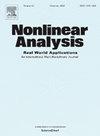A note on ideal Magneto-Hydrodynamics with perfectly conducting boundary conditions in the quarter space
IF 1.8
3区 数学
Q1 MATHEMATICS, APPLIED
引用次数: 0
Abstract
We consider the initial–boundary value problem in the quarter space for the system of equations of ideal Magneto-Hydrodynamics for compressible fluids with perfectly conducting wall boundary conditions. On the two parts of the boundary the solution satisfies different boundary conditions, which make the problem an initial–boundary value problem with non-uniformly characteristic boundary.
We identify a subspace of the Sobolev space , obtained by addition of suitable boundary conditions on one portion of the boundary, such that for initial data in there exists a solution in the same space , for all times in a small time interval. This yields the well-posedness of the problem combined with a persistence property of full -regularity, although in general we expect a loss of normal regularity near the boundary. Thanks to the special geometry of the quarter space the proof easily follows by the “reflection technique”.
四分之一空间中具有完全传导边界条件的理想磁流体力学注记
考虑具有完全传导壁边界条件的可压缩流体理想磁流体动力学方程组在四分之一空间中的初边值问题。在边界的两个部分,解满足不同的边界条件,使问题成为具有非均匀特征边界的初边值问题。我们识别Sobolev空间H3(Ω)的子空间H3(Ω),通过在边界的一部分上添加合适的边界条件获得,使得对于H3(Ω)中的初始数据在相同的空间H3(Ω)中存在一个解,在很小的时间间隔内的所有时间。这产生了问题的适定性,并结合了完全h3正则性的持久性,尽管通常我们期望在边界附近失去正正则性。由于四分之一空间的特殊几何形状,证明很容易遵循“反射技术”。
本文章由计算机程序翻译,如有差异,请以英文原文为准。
求助全文
约1分钟内获得全文
求助全文
来源期刊
CiteScore
3.80
自引率
5.00%
发文量
176
审稿时长
59 days
期刊介绍:
Nonlinear Analysis: Real World Applications welcomes all research articles of the highest quality with special emphasis on applying techniques of nonlinear analysis to model and to treat nonlinear phenomena with which nature confronts us. Coverage of applications includes any branch of science and technology such as solid and fluid mechanics, material science, mathematical biology and chemistry, control theory, and inverse problems.
The aim of Nonlinear Analysis: Real World Applications is to publish articles which are predominantly devoted to employing methods and techniques from analysis, including partial differential equations, functional analysis, dynamical systems and evolution equations, calculus of variations, and bifurcations theory.

 求助内容:
求助内容: 应助结果提醒方式:
应助结果提醒方式:


